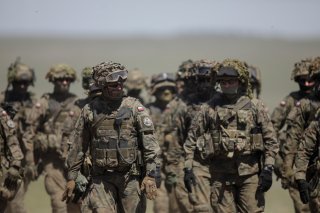Why Poland Might Be The Key To A Baltic Defense Against Russia
A greater American troop presence in Poland could serve as an important deterrant.
Here's What You Need to Remember: The idea of beefing up U.S. forces in Poland raises a few questions. If one U.S. brigade isn’t sufficient to deter Russia, will one division be any more effective? Dispatched to the Baltic States, it would still be outnumbered and with supply lines vulnerable to interdiction. And while the Polish economy is humming for now, revamping the Polish military to Western standards would be an expensive proposition.
Want to stop Russia from invading the Baltic States? Then bolster Poland’s military strength, and beef up U.S. troops in Poland.
That’s the message of a new report on how NATO can defend its Eastern European border.
“A future, more capable Polish military backed by a more robust U.S. forward presence in Poland could also foster the confidence needed for Warsaw to support the defense of NATO member territory located beyond its borders,” says the study, titled “Strengthening the Defense of NATO’s Eastern Frontier,” by the Center for Strategic and Budgetary Assessments (CSBA).
“A more capable Polish force, combined with a robust presence of U.S. forces in Poland, could assure Warsaw that it could both deter and defend against a Russian attack with fewer forces, thereby freeing up units for allied operations outside of Poland,” the study argues.
CSBA researchers started with the premise that Russia could overrun, or seize portions of, the Baltic states of Estonia, Latvia and Lithuania before NATO could intervene. This would trap the Western alliance in a dilemma between acquiescing to Moscow’s conquests or accepting the burden of launching a counteroffensive to liberate the territories. “The consequences of losing even a limited war with Russia on the European continent could prove fatal for the Alliance’s cohesion,” the authors conclude. “A Russian fait accompli, especially in the face of an unsuccessful NATO military response, could reorder Europe geopolitically and greatly reduce the credibility of U.S. security commitments to its allies and friends in Europe and other regions, including in the Indo-Pacific.”
Which leaves the question of how to deter an invasion, and how to respond if one does occur? Geography is not on NATO’s side. The Baltic States are on Russia’s western border, near Russian bases, supplies and reinforcements, while NATO forces are mostly in Western Europe and the United States. An array of Russian missiles could interdict NATO land, air and sea movements deep into Western Europe and the Atlantic, which means that NATO can’t count on relieving the Baltic nations before Russia had time to entrench.
The U.S. presence is Poland is a rotating force of an Army brigade, plus a few support elements, stationed on temporary bases. Not surprisingly, Poland would like permanent U.S. bases (what Polish president Andrzej Duda has dubbed “Fort Trump”) as a deterrent to Russia. CSBA calls for stationing what is essentially a full U.S. division, including a divisional headquarters, two Armored Brigade Combat Teams, a Stryker infantry battalion, artillery and air defense units, a combat helicopter brigade, and support units such as engineers, electronic warfare and logistics units.
In this defensive scheme, Poland isn’t a junior member of NATO, but the key to defending Eastern Europe. For example, Polish forces could neutralize the Russian enclave on Kaliningrad on the Baltic coast.
“A scenario in which Russia seeks to seize a land bridge to Kaliningrad through Lithuania provides an example of how the Polish military could perform these roles,” CSBA argues. “In such a scenario, the Polish military could defend eastern and northeastern Poland against Russian attacks while protecting and repairing ground lines of communication within Poland to facilitate the movement of NATO reinforcements to the conflict area. At the same time, Polish forces could employ their ISR [intelligence, surveillance, and reconnaissance] and long-range fires to attack Russian A2/AD [anti-access/area denial] capabilities in Kaliningrad and Belarus, as well as integrate an armored brigade into a U.S.-led division to defend the Suwalki Gap.”
This would require improving Polish military readiness, and enhancing combat enablers such as precision weapons, electronic and cyber warfare, and ISR. “Poland should replace its aging Soviet-era equipment as rapidly as possible with new capabilities that are better suited to modern high-intensity warfare and would better integrate with other NATO capabilities,” the study said.
Nonetheless, the idea of beefing up U.S. forces in Poland raises a few questions. If one U.S. brigade isn’t sufficient to deter Russia, will one division be any more effective? Dispatched to the Baltic States, it would still be outnumbered and with supply lines vulnerable to interdiction. And while the Polish economy is humming for now, revamping the Polish military to Western standards would be an expensive proposition.
Michael Peck is a contributing writer for the National Interest. He can be found on Twitter and Facebook.
This article was published previously and is being reposted due to reader interest.
Image: Reuters

